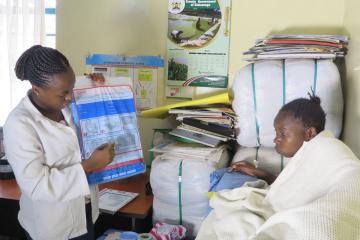
Increasing adherence to COVID-19 guidelines: Lessons from existing evidence

Please note: This note was prepared by the J-PAL Health Sector in 2020 to provide recommendations for responding to the COVID-19 pandemic. It is not an exhaustive review of all the rigorous evidence on the discussed topics.
To download this note in pdf form, click here.
As of May 2020, the novel coronavirus 2019 (COVID-19) has spread to every region of the world, infecting millions of people and killing hundreds of thousands.1 With no cure yet identified, prevention is essential. The World Health Organization (WHO), national health agencies, and other experts have issued guidance on best practices, from practicing social distancing to frequent handwashing.
Following this guidance is not necessarily easy for everyone. For instance, individuals living in overcrowded conditions may not be able to practice social distancing, those whose livelihoods depend on frequent and close interactions with others may not be able to afford it, and those without access to clean water and soap would not be able to wash their hands frequently. Other individuals may simply not be aware of the guidelines, may not understand the specific steps to follow, or they may not be convinced of the need to practice these behaviors.
In instances where lack of clear messaging or inadequate understanding of the need to practice recommended behaviors are the primary barriers to guideline adherence, evidence from rigorous research can help to inform government actions. This note provides some general lessons on increasing uptake of healthy behaviors and on improving the delivery of health products and services. It does not tailor recommendations to specific contexts or provide details on implementation. However, given the importance of tailoring interventions to suit local contexts, we encourage policymakers to reach out to Anupama Dathan, J-PAL Health Sector Manager, for follow-up conversations on incorporating the evidence into policy decisions.
Designing information campaigns to increase uptake of preventive behaviors
Many governments are advising residents to stay home, practice social distancing, regularly wash hands, and to take various other actions to prevent COVID-19. Many individuals will find it impossible to regularly practice the recommended behaviors due to financial insecurity, lack of access to clean water or soap, and various other constraints. For those who are physically able to take up these behaviors, what information is shared and through whom may influence adherence. It will also be important to avoid spreading misinformation when doing so.
Information is often impactful in changing behavior when it is specific and actionable.
Simply urging people to change behavior usually does not work. This insight comes from a number of studies from around the world, focused on a number of health topics.2 For instance, providing health insurance consumers in the United States with specific and personalized price information on the cost of prescriptions increased the likelihood of consumers switching plans and decreased annual consumer costs (Kling et al. 2012).
- Recommendation: Specific and actionable information campaigns to encourage key preventive behaviors for COVID-19 may be particularly effective. Experts may find it beneficial to continue issuing specific information on what behaviors to take up and why these actions are important. For example, advice to systematically wash hands upon returning from the grocery store or to set an alarm to remember to wash hands every 2 hours may be more effective than more general exhortation to “wash hands regularly.” Likewise, encouragement to replace handshakes with head nods or elbow bumps may be more actionable than simply telling individuals to avoid handshakes.
It is important to leverage the influence of peer networks such as friends and neighbors when asking individuals to take up new behaviors.
While top-down messaging that is framed in a specific and actionable way can change behavior, leveraging the community is also important for sustained behavior change.3 For example, a study in Nepal found that high school girls whose friends received a menstrual cup were more likely to adopt them as well (Thornton and Oster, 2008). Two experiments from India demonstrated that highly central individuals in a community may be particularly effective at spreading important information and that community members are able to identify such individuals quite reliably (Banerjee et al. 2019). In rural Peru, a large-scale handwashing intervention in 2010 involving a mass media campaign (radio, posters, and promotional events) alongside a community-based training improved knowledge and modified behaviors, while mass media alone had no impact. The campaign led to more households correctly identifying that water and soap was the best way of washing hands and increased the number of people washing their hands before eating (Galiani et al 2015; Galiani et al. 2012).
- Recommendation: Directly leveraging the influence of well-connected community members and peers (while avoiding face-to-face interactions) may help to spread accurate information on new recommendations. While guidelines on social distancing make in-person interactions difficult, online and mobile platforms may be good ways to leverage this influence.
Edutainment may be a promising delivery method for key public health messages and increasing take-up of health products.
Television, radio, or other entertainment platforms can be used to change attitudes and behaviors by embedding educational messages in a bigger storyline.4 In Nigeria, for example, the edutainment television series MTV Shuga improved knowledge and attitudes towards HIV and risky sexual behavior and increased the likelihood of getting tested for HIV (Banerjee et al. 2019). Effects were stronger for viewers who reported being more involved with the story or identified with the characters.
- Recommendation: Where possible, incorporating key public health messages on social distancing and hand washing into new or existing entertainment media could help improve adherence to recommended behaviors. The increased time spent at home due to COVID-19 lockdown orders and the ability to identify with characters facing similar changes to their personal life may further underscore edutainment’s potential to influence individual behavior. Edutainment may be difficult to produce under social distancing practices; however, animation or other art could potentially ease some of these concerns.
Engaging celebrities in sharing key health messages can increase the reach of these messages.
In Indonesia, a study leveraging Twitter found that celebrity endorsement significantly increased the likelihood that a tweet promoting immunization was liked or retweeted relative to similar tweets without celebrity endorsement. The effect was particularly large when celebrities were seen as speaking in their own voice, rather than citing external sources. By contrast, explicitly citing sources in the tweets actually reduced diffusion (Alatas et al 2020).
- Recommendation: Educating celebrities early on in an epidemic and leveraging their voices can help to avoid the spread of misinformation or the undermining of public health campaigns. Depending on the content and accuracy of their message, all individuals with a media following can have a positive or negative impact on public opinion and behavior. Celebrity influence may continue to be important for raising the profile of COVID-19 in the medium-term, when the current level of awareness has subsided but preventive measures are still important. Note that, to date, this recommendation is based on a single study rather than a broader body of research.
Evidence on information provision demonstrates that receiving messages from those with whom one feels a connection—community members, peers, characters on TV shows and other forms of entertainment, celebrities, etc.—can be important for uptake of recommended behaviors. Messaging this information with specific and actionable steps can be additionally impactful. It is also important to avoid spreading misinformation through these platforms.
Leveraging cash transfers to increase uptake of preventive behaviors
Cash transfers can act as both income support and encourage uptake of healthy behaviors.
Since the COVID-19 pandemic is a health crisis accompanied by a severe economic one, cash transfers can provide income support and potentially increase uptake of healthy behaviors.
A review of the literature shows that offering conditional cash transfers (CCTs) that require households to meet certain conditions on healthy behavior generally increases adoption of targeted behaviors.5 In some cases, making households aware of the importance of such behaviors and implying that the transfer should be used for them, without strong enforcement of conditions, also contributed to the increase in health service utilization.
Providing cash with no conditions, or unconditional cash transfers (UCTs), increases spending on household priorities and often improves overall household well-being. However, improved health outcomes are difficult to detect unless the cash transfer is very large.
- Recommendation: Cash transfers can be leveraged to increase uptake of healthy behaviors. Both UCTs and CCTs have costs associated with determining eligibility, targeting the transfer to intended households, and delivering the cash. Additionally, the conditions in a CCT can be soft (unenforced) or hard (enforced), or the transfer can also be unconditional but accompanied by specific, actionable information. When determining which type of transfer to implement, policymakers may consider the outcome(s) they are hoping to achieve, as well as the relative costs and benefits of each type of transfer across all target outcomes. A CCT with hard conditions has additional costs associated with monitoring which households are adhering to the conditions, which vary based on the design and strictness of the conditions, as well as on local capacity for monitoring and enforcing the conditions. If implementing a CCT, it will be important to determine what desired behaviors would be conditioned and whether monitoring take-up of these behaviors is feasible, or whether to rely on soft conditions or information provision instead. For instance, a hard condition may be possible if focused on testing for COVID-19, but a soft condition or information provision may be preferred if the priority is ensuring adherence to a lockdown or shelter-in-place policy.
Strategies to improve the delivery of health products and services
The practices described above can help motivate individuals and households to take up healthy behaviors. As governments and other actors think through distribution of essential commodities once they are developed, research yields insights on how to deliver them to maximize uptake.
Increased trust in the health system may be critical for more community cooperation with health guidelines.
A study in Sierra Leone found during the 2014-16 Ebola crisis that community monitoring of government-run health clinics and status awards for clinic staff (both implemented roughly two years prior to the Ebola health crisis) improved the community's perception of health care quality, utilization of health services, and Ebola-related health outcomes. During the crisis, the interventions increased Ebola testing rates and reduced mortality among patients, driven by improvements in the community monitoring intervention (Christensen et al. 2020). A study from the United States similarly showed the importance of trust in the health care system: black men, typically more mistrustful of the health care system, were more likely to trust providers of the same race. Seeing doctors they trusted increased their preventive health care utilization rate, including receiving the seasonal flu vaccine (Alsan et al. 2019).
- Recommendation: Programs or policies that increase trust in the health system could improve reporting and cooperation with health guidelines, which in turn could help increase testing, reduce the spread of the disease, and reduce mortality. In the study from Sierra Leone, the social accountability intervention had been implemented prior to the Ebola health crisis. Still, interventions that increase trust may be most impactful in areas with low baseline utilization of health care services or amongst populations with low levels of trust in the health system (including marginalized groups that may include migrants, LGBTQ individuals, indigenous communities, or racial minorities depending on the context). Additional trust-building policies, such as ensuring patient confidentiality with regard to immigration status, could also help address wariness of the formal health system. Such measures would most likely improve the resiliency of the health systems over time; they may also possibly improve outcomes if implemented during or right before a major health shock, though this has not been studied to date. Note that, to date, this recommendation is based on two studies rather than a broader body of research.
Providing recommended preventive health products such as COVID-19 tests, masks, an eventual vaccine, and others for free (once supply-side shortages are addressed) can help to ensure mass uptake.
Uptake of preventive health products, such as vaccines, is highly sensitive to price. A large body of evidence shows that take-up reduces dramatically even with small price increases, and especially so for products with large social externalities.6 For example, when a program in Kenya moved from free provision of deworming tablets to charging US$0.30 per child, take-up fell from 75 percent to 18 percent (Kremer and Miguel 2007). Furthermore, preventive products distributed for free have generally been put to good use.
- Recommendation: When feasible, subsidizing recommended preventive health products and eliminating user fees can increase uptake. There is currently a severe shortage of preventive products such as protective masks and COVID-19 tests, and a COVID-19 vaccine is not yet available. Once these supply-side issues have been addressed, providing these recommended products for free to the target population can ensure immediate, mass uptake.
This note highlights some general lessons on how policymakers may be able to increase adherence to COVID-19 guidelines and improve the delivery of key health products once they are readily available. It does not intend to provide details on implementation. Policymakers interested in learning more about the evidence presented here are encouraged to reach out to Anupama Dathan, J-PAL Health Sector Manager, for follow-up conversations on incorporating the evidence into policy decisions.
For more information, see this webinar by J-PAL Health Sector co-chairs, Karen Macours and Pascaline Dupas, on "Insights from behavioral economics for adherence to COVID-19 recommendations and improving service delivery during the current crisis."
1. World Health Organization. 2020. “Coronavirus disease 2019 (COVID-19): Situation Report 107.”
2. Studies from J-PAL affiliates on specific and actionable information provision include, Galiani et al. 2015; Bennear et al. 2013; Dupas 2011; Dupas et al. 2018; Maughan-Brown et al. 2015; Meredith et al. 2013; Kling et al. 2012
3. Studies from J-PAL affiliates on peer effects and social networks for health include Dupas 2014; Oster and Thornton 2012; Kremer and Miguel 2007; Goldberg et al. 2019; Banerjee et al. 2019
4. Studies from J-PAL affiliates on edutainment include Banerjee et al. 2019; Banerjee et al. 2016; Green et al. 2018
5. J-PAL's policy insight on the topic is available here.
6. J-PAL’s policy insight on the topic is available here.






